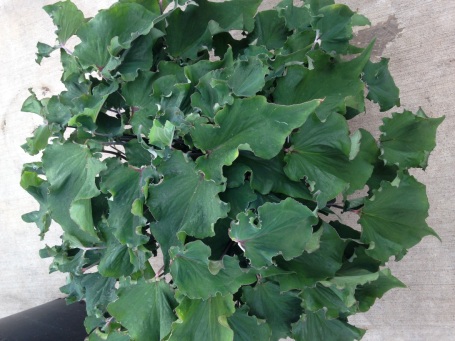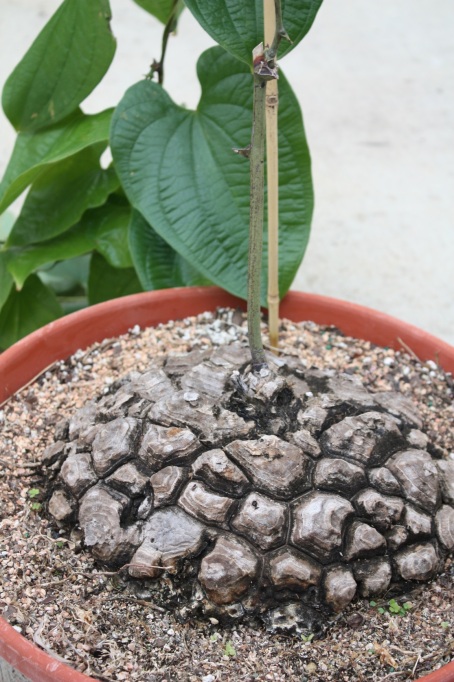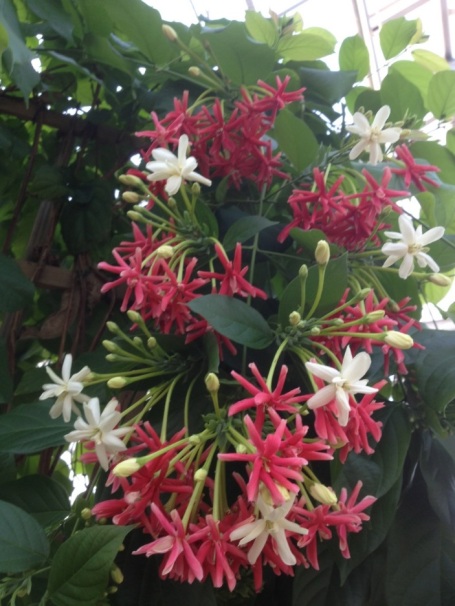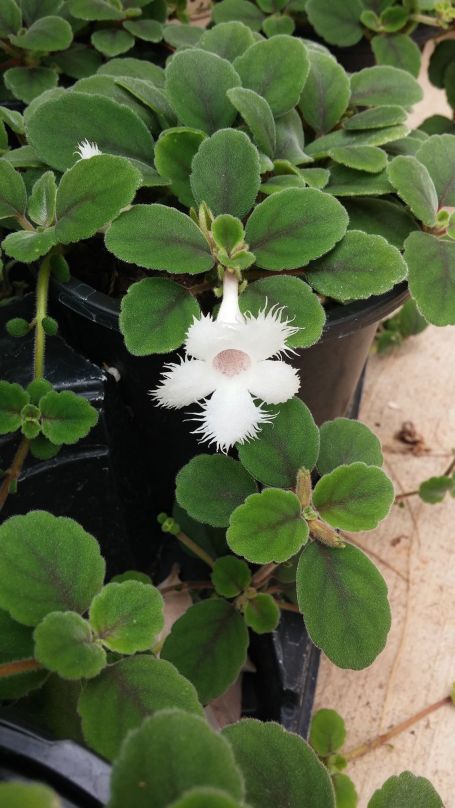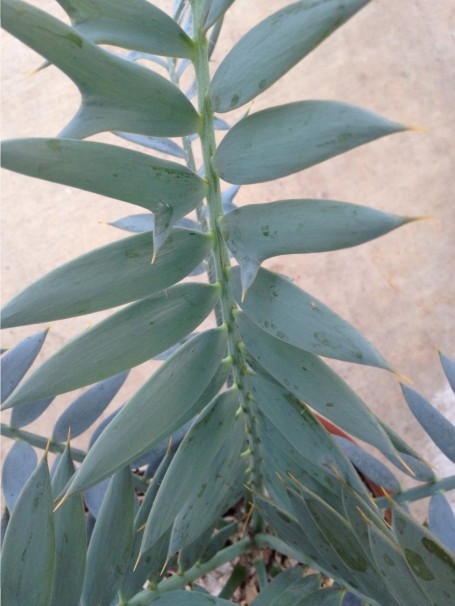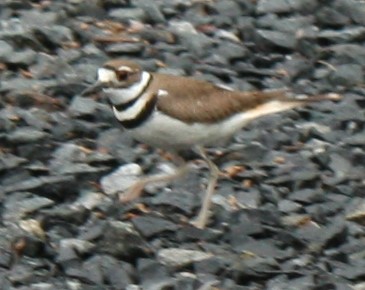Posts tagged ‘greenhouse’
Rare and Beautiful Orchids (and a Horticulturist) Find Home at Smithsonian Gardens
Imagine opening an innocuous cardboard box and finding this inside!
I was fortunate to have this pleasure on one of my first days on the job as a horticulturist with Smithsonian Gardens. Already amazed (and slightly overwhelmed) by the diversity of orchids in the Smithsonian Gardens Orchid Collection, my first week on the job included helping my colleagues unpack a tractor trailer full of boxes containing a major donation of orchids.

Anne, a Smithsonian Gardens volunteer, assists Emily and the other greenhouse staff unpack boxes of donated orchids.
Hundreds of specimens were added to the orchid collection at the Smithsonian Gardens Greenhouse Facility in Suitland, MD. The plants were part of an extensive collection owned by the late Denis Roessiger of Penobscot, ME, that have been generously donated by his wife, Lucybelle.
Horticulturists from the Smithsonian Gardens greenhouses journeyed to Maine to select and carefully pack up the orchids, which then travelled overnight by truck to the Suitland greenhouse facility. There, greenhouse staff and volunteers eagerly unloaded and unpacked the vast array of plants. “This donation is exceptional in that 99% of the orchids are species orchids or rare hybrids,” commented Smithsonian Gardens Orchid Specialist, Tom Mirenda. The donation is a major addition to the Smithsonian Gardens’ collection, adding entirely new genera to it and increasing the species abundance and overall diversity.
I asked Tom Mirenda to give me a walk-through of the highlights of the donation. Here are his top picks:

(L to R) Bulbophyllum amplebracteatum subsp. carunculatum ‘Sunset Valley Orchids’ and Bulbophyllum cocoinum
Over 200 new Bulbophyllum specimens now complement the already extensive collection of this genus maintained by Smithsonian Gardens. Bulbophyllum is one of the largest and most ancient genus of orchids; found in tropical forests around the world, they are often odd-looking plants with peculiar, sometimes foul, fragrances. “One of my favorites currently in bloom is Bulbophyllum cocoinum, which has a coconut fragrance,” says Mirenda. The donation also included fifteen species of Trichoceros, a new genus for the collection. Trichoceros are epiphytic and terrestrial orchids native to the Andean Mountain range in South America.
The donation tripled Smithsonian Gardens’ collection of hard to find Maxillaria orchids, and added 50 to 70 species of Restrepia and several large specimen Coelogyne and Dendrochilum. Also new to the collection are several Lycaste and Dracula species. Rare color forms of Laelia and Cattleya now grace the collection. Orchid enthusiasts will swoon at the large addition of South American Slipper Orchids (Phragmipedium), particularly the controversial Phragmipedium kovachii—the orchid at the heart of the book, Scent of a Scandal.
Large, brilliant, purple flowers of an eight-foot Vanda were one of the showiest surprises during unpacking. One of the Smithsonian greenhouses has been transformed with the addition of roughly 40 Vandas now hanging from the ceiling and suspended racks.
With the acquisition of these plants, our orchid collection now has well over 10,000 specimens. “By continually building our collection in this way, we have made the Smithsonian Gardens Orchid Collection a true scientific resource,” says Mirenda.
– Emily Cook, Horticulturist, Smithsonian Gardens
Matt’s Top 5 Tropicals for 2015
The Smithsonian Gardens’ tropical plant collection includes approximately 1,000 plants. This number fluctuates on a fairly regular basis as some plants die from natural causes while others grow so large that they outgrow their display space or even the Smithsonian Gardens’ greenhouse facility. As the caretaker of this collection, I have a special relationship with the plants and, though I care for them all, I do have a few favorites. Here is a list of my personal top 5 favorite plants in the Smithsonian’s tropical plant collection (in no particular order) along with where to catch them on display this summer.
First up is Caladium schomburgkii ‘Skula.’ This relatively unknown caladium is subtle, but for some reason is a favorite of mine. Could it be the interesting leaf shape, or perhaps its various hues of green leaves, or simply its ease of care? I honestly don’t know why I like this plant so much but see for yourself and make your own decision. Location: Enid A. Haupt Garden
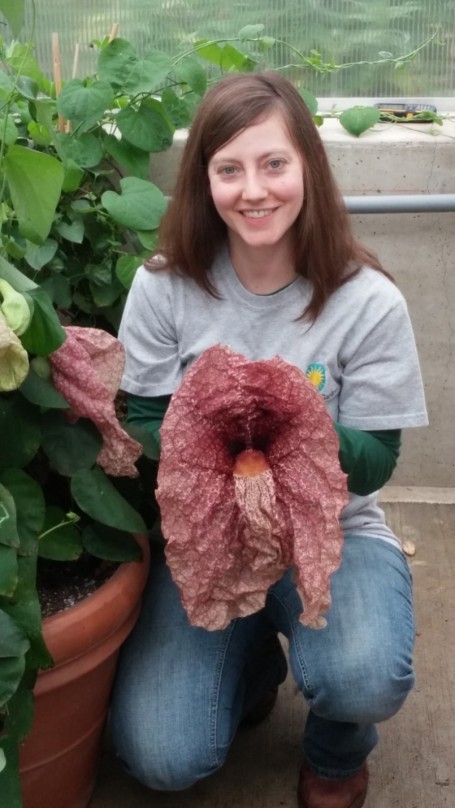
Aristolochia gigantea ‘Brasiliensis.’ My coworker, Shannon, was kind enough to pose with the flower to give you an idea of its size.
Once you see Aristolochia gigantea ‘Brasiliensis’ flowers you will know why this tropical made my top 5 list. It took me a few tries to cultivate this plant. I previously obtained two specimens and both times when they flowered they ended up being straight A. gigantea. My third attempt was well worth the trouble, however. This plant produces flowers nearly year-round and what a display they make! The flowers measure nearly 12 inches wide and before opening they have a fascinating side profile that resembles a smoking pipe. Aristolochia ridicula was close to making my list as well (check out its flowers). Location: Mary Livingston Ripley Garden
Dioscorea mexicana, also called Mexican Yam, is one of the coolest looking plants you will ever see. The plant’s caudex (stem base) looks like a tortoise shell. The glossy heart-shaped leaves are attractive and can grow 15 feet in a single growing season. While pretty, the flowers are small so it’s best to enjoy this plant for its foliage and oh so interesting caudex. Location: Enid A. Haupt Garden
Combretum indicum ‘Flora Plena,’ the second vine on my list, is certainly a show stopper. This doubled flowered cultivar is not only visually breathtaking but also pleasantly fragrant. The flowers start out white and as they age change over to various hues of pink and red. Location: Enid A. Haupt Garden
Alsobia dianthiflora is also known by its common name, Lace Flower. A simple plant with fuzzy green leaves and a dark midrib, it looks nice year-round but really shines when it’s shredded-edged white flowers start to bloom. This plant also makes for a great house plant. Location: Enid A. Haupt Garden
A bonus plant to add to this list is expected to make its appearance in the Smithsonian Gardens during the summer of 2016 or 2017. Encephalartos horridus is an amazing blue cycad. I acquired a small offset in the fall of 2012 and have been caring for it ever since. The International Union for Conservation of Nature lists this plant as Endangered. It is native to South Africa. E. horridus has spectacular blue fronds that make it a truly special specimen.
So there you have it–my current top 5 plants under my care here at Smithsonian Gardens. I hope you enjoy them as much as I do and please stop by our gardens and check them out in person if you have a chance.
– Matt Fleming, Smithsonian Gardens Horticulturist
Bluebirds and Company: What’s Chirping at the Smithsonian Gardens’ Greenhouses
The summer season brings new life to the Smithsonian Gardens’ greenhouses. As you might expect, much of this new life is the result of staff work to produce plants for our gardens. However, there are also a surprising number of winged, chirping occupants on the greenhouse property this season. As a part of the Bluebird NestWatch effort organized by the Cornell Lab of Ornithology, Smithsonian Gardens has set up ten specially-designed bluebird houses around the greenhouse property. The greenhouse staff visits each birdhouse weekly and unscrews a side wall to make notes of the visitors and nest progress. Often times they find other species of birds occupying the houses, so it’s really a fantastic glimpse at a variety of bird life. During the past several weeks of collecting data, we’ve seen Bluebirds, Wrens, Tree Swallows, and Robins making their nests in these houses.
We also regularly see ground-nesting Killdeer around the greenhouse. Preferring ground mobility to flight, these birds are fast runners from an early age. This makes them difficult to approach especially as they are easily spooked. Though not one of our birdhouse residents, the Killdeer nest quickly became a weekly checkpoint for our observation tours and we were able to see four chicks this year.
It’s easy to imagine that the parents of these chicks were not particularly pleased with our weekly interruptions. As a result, we rapidly learned each bird’s defense strategy. Bluebirds are often shy creatures and the parents would fly to a vantage point to watch us with a keen eye while we conducted our research. Tree Swallows, on the other hand, are a little more aggressive and would dive-bomb us to get us to leave their nest alone. Adult Robins and Wrens would often just flee the coop entirely and wait for a quiet time to revisit their brood.
Killdeer, on the other hand, have developed a pretty impressive show to protect their young which uses camouflage, predator calls, and distraction performances. Killdeer often hang out near our gravel walks or driveways where, as seen in the picture below, their neutral colored feathers help them blend into the background. Under the cover of camouflage, the adults would use alarm calls to attract attention to themselves and away from their babies when we approached the nest. When that failed, the adults would lay down and stretch out their wings like they had been injured to make themselves appear an appealing victim to the perceived predator. Once the threat (in this case the greenhouse staff) was fooled by the adult Killdeer’s show and moved to approach, the adult would wait for the the chicks to be safely out of reach before miraculously “recovering” and flying away to safety. There’s nothing more humbling than being duped by the oldest trick in the book.
All in all, it’s been a terrific and refreshing few weeks for the greenhouse staff to get outside and witness the beauty of avian life. During this project we’ve not only seen countless chicks and eggs, we’ve also seen the these young birds develop from day-old hatchings into fledglings ready to fly. Despite being attacked by adults aggressively protecting their young and mocked by flawless Killdeer performances, it’s been a pleasure seeing the diversity of bird life out at the Smithsonian Gardens greenhouses.
– Alan Marcus, Smithsonian Gardens Intern
DIY: Hanging Baskets
The Smithsonian Gardens greenhouse production team creates 200 hanging baskets for display throughout our gardens each year. Baskets are produced in three sets and changed out each spring, summer, and fall season.
Production team members Joe and Jill were kind enough to share a behind-the-scenes look at how they create these popular hanging additions to our gardens.
This year Jill and Joe useed a combination of Calibrachoa Minifamous ‘Double Deep Yellow’, Lobelia erinus Laguna ‘Sky Blue’, and Sutera cordata Snowstorm ‘Giant Snowflake’ in our spring baskets. The result? An EXPLOSION of yellow, blue, and white! You can see these spectacular baskets now out in our Enid A. Haupt Garden and Kathrine Dunlin Folger Rose Garden.
Here’s a step-by-step guide showing how our pros create the baskets for our gardens. DIYers, we’re looking forward to seeing pictures of what you create!
Cultivate ’14: Plants and Art
I had the opportunity to travel to Columbus, Ohio, last July to attend Cultivate ’14. This annual conference is held for people from all aspects of the horticulture industry, including growers, retailers, landscapers, interior plantscapers, floral designers, and educators. With educational sessions, the largest horticultural trade show in North America, wonderful tours to attend, and over 10,000 attendees, there was so much to see and learn while I was there.
As part of the conference, I was fortunate to be able to visit the Franklin Park Conservatory and Botanical Gardens in Columbus. I have always been fond of conservatories and greenhouses, and this one did not disappoint! The conservatory itself, comprised of 8,300 sq. ft. of glass roof space, first opened its doors to the public in 1895 to show off its collection of palms.
One aspect that really drew me in to all of the beautiful plant displays there were the Dale Chihuly glass pieces that were exhibited throughout the conservatory. I learned that Chihuly’s artwork was first displayed in the conservatory in 2003. Because of a marked increase in attendance, the Friends of the Conservatory decided to purchase many of those glass pieces so that they could be shown permanently. There is something about the way the beautiful glass, with its electric colors, reflects the sun in such a gorgeous setting. It warms me from the inside out.

Sunset Tower by Dale Chihuly at the Franklin Park Conservatory and Botanical Gardens, Columbus, Ohio
That really got me thinking about how important art is in the garden: bringing these two elements together to draw in people to see the gardens. It is a way for gardeners and plant lovers to come to such a lovely, natural setting to appreciate art. It is equally as valuable to bring lovers of art into a garden setting, which is beautiful and imperfect—quite a different setting to display artwork than the stark white walls that we often see in a gallery—and enable them to appreciate the artwork in a more natural setting. The synergy created by placing these two components of artwork and gardens in the same space makes the combination of the two work that much more effectively together than they would on their own.
We at Smithsonian Gardens are so fortunate to have such a beautiful backdrop in which to display our plants. The museums themselves are works of art, inside and out. We have entire gardens that are dedicated to displaying artwork (such as the Hirshhorn’s Sculpture Garden), and others that are gardens, first and foremost, that also display artwork (the Haupt Garden, American Indian Museum, and Natural History Museum, to name a few).
I work primarily with plants used in interior spaces, and while I can’t necessarily work with “gardens” and artwork, the plants I grow and care for in the Smithsonian greenhouses are used inside the museums where even more pieces of art are displayed. The trip to Franklin Park Conservatory has inspired me to think more creatively about the plants I grow, and to consider new ways in which the plants can be arranged to complement the artwork they will be placed around, or even the space in which the plants will be displayed.
The next time you visit a space that displays horticulture and art, take the time to appreciate how much more you get out of your experience by having both plants and artwork working together.
– Shannon Hill, Greenhouse Horticulturist
March 26, 2015 at 10:00 am smithsoniangardens Leave a comment
What Happens When a Bunch of Horticulturists Get Together?
They all go to Cultivate ’14 in Columbus, Ohio in July.
I had the wonderful experience of attending Cultivate ’14 in Columbus, Ohio July 12 – 15, 2014. Formally known as the Ohio Short Course, the symposium is one of the largest events in North America. The show is attended by over 9,000 garden retailers, greenhouse growers, landscapers, interior designers, educators, researchers, and many other professionals involved in the green industry.
Top notch educators and speakers are invited to speak on over 140 topics about pest control, new plant varieties, growing techniques, interior design, and green walls. Attendees have the flexibility to attend as many of the seminars as they can. Attending these seminars is a great way to get new ideas on growing techniques, identifying common diseases and insects that may attack greenhouse crops, and even proper techniques on using yellow, sticky insect trap cards.
The trade show is the one of the largest around. I was able to walk around at my leisure and see all of the new and innovative products that are available or will be made available to our industry in the future. The trade show is also a great time to network with sales representatives that I talk to sometimes on a weekly basis. I also establish new relationships with salespeople trying to sell the newest and brightest products in the industry. Personally, the trade show is a wonderful opportunity to “hook up” with former coworkers and sales representatives I have known for over twenty years.
One of the highlights of the show is getting to see many of the new plant varieties and introductions. There are hundreds of new and exciting plants and colors at the show. Aisle after aisle of annuals and perennials line the lobby at the convention center. Many of these new varieties can be seen in the fabulous displays all throughout the show. I gain a ton inspiration when looking at the wonderful new selections and then enjoy bringing all of my inspiration back to share with my coworkers at Smithsonian Gardens.
Another wonderful highlight of the trip is the bus tour to greenhouse operations in the Ohio area. I was able to tour two family owned production/retail facilities. Going on the tours allows me to see what other growers are doing and taking a peek at their innovative ways of producing large quantities of high quality plant material to be sold to retail garden centers. The bus trips also establish relationships with other people in the industry. Conversations are started and soon everyone on the bus seems to know one another. Information and ideas are exchanged while spending most of the day on the bus. These people on the bus come from all over the country. My bus had people that came all the way from Canada and Hawaii!
The really fun part of the trip to Cultivate ’14 was the visit to the Franklin Park Conservatory a couple of miles outside the city limits. Their display of Chihuly glass (more than 3,000 pieces in the permanent collection) was awesome! The plants displays were amazing as well. Highlights of the conservatory included a palm house, a rain forest, a butterfly house, lots of amazing bonsai, and a gift shop and café.
Attending Cultivate is always a wonderful experience. The event is truly a great opportunity to become motivated and inspired by all of the beauty and knowledge the show brings to the green industry and to me.
–Jill Gonzalez, Smithsonian Gardens Horticulturist
January 28, 2015 at 7:20 am smithsoniangardens Leave a comment
Thank You to all of our Smithsonian Gardens’ Volunteers!

Volunteer garden interpreters Susan and Peggy talk with the public in the Haupt Garden.
As the year comes to a close, we wanted to pause for a moment to thank our awesome volunteers for all they do. Volunteers work alongside Smithsonian Gardens’ staff to help plant, care for and display the plants in our gardens. They also interact with the public in our gardens, help prepare educational materials, and work with our archival collections. Last but not least, volunteers have special access to our garden programs, special events, and the chance to meet fellow garden lovers.
This fall we wrapped up another successful season of garden tours and programs. Volunteer interpreters in our gardens this past spring, summer and early fall donned their Smithsonian Gardens’ shirts and headed out to our Haupt and Butterfly Gardens. They interacted with visitors of all ages and interests through storytelling and hands-on activities as well as by fielding all sorts of questions about our gardens.
In the Smithsonian Gardens’ greenhouses, volunteers played an important role this past year in propagating annuals and caring for our award-winning orchid collection, tropical plants and perennials. Outside they assisted with planting bulbs and annuals and maintaining our garden landscapes. Their work helped make our gardens an oasis for our visitors year-round.

Volunteer Laurel helps care for plants at the Smithsonian Gardens’ Greenhouses.
This winter, many of our Smithsonian Gardens’ volunteers will escape the cold by staffing our upcoming orchid exhibit in the National Museum of Natural History. The exhibit will focus on the importance of orchids to Latin American cultures and traditions. Volunteers will interact with exhibit visitors, answer questions, and encourage people to think about the important roles that plants play in their lives.
All of our Smithsonian Gardens’ volunteers contribute to the excellence of our gardens and programs. We could not do it without them!
If you are interested in volunteering with Smithsonian Gardens, visit our SG volunteer page at http://gardens.si.edu/get-involved/volunteers.html.
December 27, 2012 at 8:00 am smithsoniangardens Leave a comment




